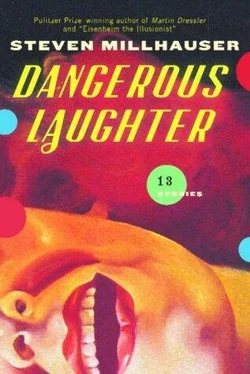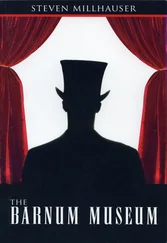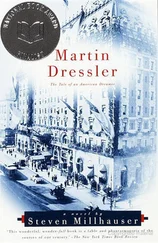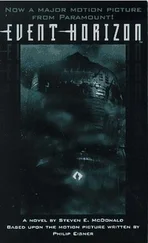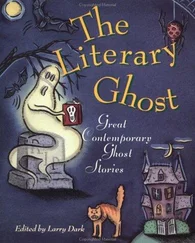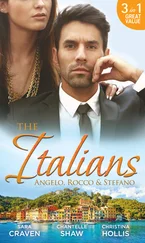In this atmosphere of playfulness, extravagance, and illusionist wit, the paintings of Harlan Crane attracted no unusual attention, although we sometimes hear of a “disturbing” or “uncanny” effect. He displayed three paintings. Still Life with Fly #2 showed an orange from which the rind had been partially peeled away in a long spiral, half a sliced peach with the gleaming pit rising above the flat plane of its sliced flesh, the hollow, jaggedly broken shell of an almond beside half an almond and some crumbs, and an ivory-handled fruit knife. To the side of the peach clung a vertical fly, its wings depicted against the peach skin, its head and front legs rising above the exposed flesh of the peach. An iridescent drop of water, which seemed about to fall, clung to the peach skin beside the fly. A number of viewers claimed that the fly suddenly left the canvas, circled above their heads, and landed on the upper-right-hand corner of the frame before returning to the peach beside the glistening, motionless drop. Several viewers apparently swatted at the fly as it flew beside them, but felt nothing.
A second painting, Young Woman, is the only known instance of a portrait in the oeuvre of Harlan Crane. The painting showed a girl of eighteen or nineteen, wearing a white dress and a straw bonnet with a cream-colored ostrich plume, standing in a bower of white and red roses with sun and leaf-shadow stippling her face. In one hand she held a partly open letter; a torn envelope lay at her feet. She stood facing the viewer, with an expression of troubled yearning. Her free hand reached forward as if to grasp at something or someone. Despite its Verisimilist attention to detail — the intricate straw weave of the bonnet, the individual thorns on the trellis of roses — the painting looked back to the dreary conventions of narrative art deplored by Verisimilists and Transgressives alike; but what struck more than one viewer was the experience of stepping up close to the painting, in order to study the lifelike details, and feeling the unmistakable sensation of a hand touching a cheek.
The third painting, The Escape, hung alone in a small dusky niche or alcove. It depicted a gaunt man slumped in the shadows of a stone cell. From an unseen window a ray of dusty light fell slantwise through the gloom. Viewers reported that, as they examined the dark painting, in the twilit niche, the prisoner stirred and looked about. After a while he began to crawl forward, moving slowly over the hard floor, staring with haunted eyes. Several viewers spoke of a sudden tension in the air; they saw or felt something before or beside them, like a ghost or a wind. In the painting, the man had vanished. One journalist, who returned to observe the painting three days in succession, reported that the “escape” took place three or four times a day, at different hours, and that, if you watched the empty painting closely, you could see the figure gradually reappearing in the paint, in the manner of a photographic image appearing on albumen paper coated with silver nitrate and exposed to sunlight beneath a glass negative.
Although a number of newspapers do not even mention the Crane paintings, others offer familiar and bogus explanations for the motions, while still others take issue with descriptions published in rival papers. Whatever one may think of the matter, it is clear that we are no longer dealing with paintings as works of art, but rather with paintings as performances. In this sense the Brewery Show represents the first clear step in Harlan Crane’s career as an inventor-showman, situated in a questionable realm between the old world of painting and the new world of moving images.
It is also worth noting that, with the exception of Lowe’s Writing Desk, Transgressive paintings are not trompe l’oeil. The trompe l’oeil painting means to deceive, and only then to undeceive; but the real ivy and the real grapes immediately present themselves as actual objects disruptively continuing the painted representation. Harlan Crane’s animate paintings are more unsettling still, for they move back and forth deliberately between representation and deception and have the general effect of radically destabilizing the painting — for if a painted fly may at any moment suddenly enter the room, might not the painted knife slip from the painted table and cut the viewer’s hand?
After their brief moment of notoriety in 1877, the Transgressives went their separate ways. Samuel Hope, Winthrop White, and C. W. E. Palmer returned to the painting of conventional still lifes, Robert Allen Lowe ventured with great success into the world of children’s book illustration, and John Frederick Hill devoted his remaining years to large, profitable paintings of very white nudes on very red sofas, destined to be hung above rows of darkly glistening bottles in smoky saloons.
Crane now entered a long period of reclusion, which only in retrospect appears the inevitable preparation for his transformation into the showman of 1883. It is more reasonable to imagine these years as ones of restlessness, of dissatisfaction, of doubt and questioning and a sense of impediment. Such a view is supported by the few glimpses we have of him, in the correspondence of acquaintances and in the diary of W. C. Curtis. We know that in the summer of 1878 he took a series of photographs of picnickers on the Hudson River, from which he made half a dozen charcoal sketches that he later destroyed. Not long afterward he attempted and abandoned several small inventions, including a self-cleaning brush: through its hollow core ran a thin rubber tube filled with a turpentine-based solvent released by pressing a button. For a brief time he took up with Eliphalet Hale and the Sons of Truth, a band of painters who were opposed to the sentimental and falsely noble in art and insisted on portraying subjects of a deliberately vile or repellent kind, such as steaming horse droppings, dead rats torn open by crows, blood-soaked sheets, scrupulously detailed pools of vomit, rotting vegetables, and suppurating sores. Crane was indifferent to the paintings, but he liked Hale, a soft-spoken God-fearing man who believed fervently in the beauty of all created things.
Meanwhile Crane continued to take photographs, switching in the early 1880s from wet-collodion plates to the new dry-gelatin process in order to achieve sharper definition of detail. He also began trying his hand at serial photography. At one period he took scores of photographs of an unknown woman in a chemise with a fallen shoulder strap as she turned her face and body very slightly each time. He tested many kinds of printing paper, which he coated with varying proportions of egg white, potassium iodide, and potassium bromide, before sensitizing the prepared paper in a solution of silver nitrate. He told W. C. Curtis that he hated the “horrible fixity” of the photographic image and wished to disrupt it from within. In 1881 or 1882 we find him experimenting with a crude form of projector: to an old magic lantern he attached a large, revolving glass disk of his own invention on which transparent positives were arranged in phase. One evening, to the astonishment of Curtis, he displayed for several seconds on a wall of his studio the Third Avenue El with a train moving jerkily across.
But Crane did not pursue this method of bringing photographs to life, which others would carry to completion. Despite his interest in photography, he considered it inferior to painting. After attending a photographic exhibition with W. C. Curtis, he declared: “Painting is dead,” but a week later at an oyster bar he remarked that photography was a “disappointment” and couldn’t compare with paint when it came to capturing the textures of things. What is striking in the career of Harlan Crane is that more than once he seemed to be in the direct line of invention and experimentation that led to the cinema of Edison and the Lumières, and that each time he turned deliberately away. It was as if he were following a parallel line of discovery, searching for an illusion of motion based not on serial photographs and perforated strips of celluloid, but on different principles altogether.
Читать дальше
